Обзор Nikon AF-S Nikkor 20mm f/1.8G ED — характеристики
Отличительной особенностью объектива Nikon 20mm f/1.8 является сочетание большого фокусного расстояния и большой диафрагмы. Фокусного расстояния 20 мм, разработанного для 35-мм полнокадровых камер, должно быть достаточно, чтобы захватить даже самые широкие перспективы — хотя такие широкоугольные виды могут выглядеть очень драматично, когда вы там, они часто не превращаются в хорошую фотографию, если нет чего-то интересного. заполнение пространства на переднем плане. Имея это в виду, диафрагму f/1,8 можно использовать для создания малой глубины резкости, гарантируя, что только объект на переднем плане будет резким, а фон будет расплываться. Это противоречит правилам пейзажной фотографии, согласно которым все на изображении должно быть резким, но использование малой глубины резкости может сделать некоторые очень интересные снимки.
Тем, кто снимает звездные пейзажи, также понравится преимущество диафрагмы f/1.8. Съемка таких изображений, особенно без добавления шума, зависит от наличия большой диафрагмы, чтобы можно было захватить как можно больше света от звезд — диафрагма f / 1,8 должна быть в состоянии захватить как тускло освещенный пейзаж, так и звезды. Старое правило гласит, что для того, чтобы звезды на небе были четкими, время экспозиции должно быть не более 600, деленное на фокусное расстояние объектива, поэтому 30-секундной экспозиции должно быть достаточно при использовании фокусного расстояния 20 мм.
Семилепестковая диафрагма создает прекрасный 14-точечный блик в форме звезды при съемке в условиях яркого света.
Объектив 20 мм f/1.8 использует нанокристаллическое покрытие Nikon для уменьшения бликов и хроматических аберраций. Два асферических элемента и два элемента ED (со сверхнизкой дисперсией) обеспечивают четкость изображения и минимальное искажение.
Несмотря на то, что объектив не имеет системы стабилизации изображения Nikon Vibration Reduction на основе объектива, это не должно быть проблемой, поскольку с этим объективом можно снимать с рук при выдержке около 1/30 с и при этом получать четкие изображения.
Фотографы будут довольны тем, что этот объектив оснащен тихим двигателем Sonic Wave Motor (SWM), а также задней фокусировкой. Это означает, что передняя линза не выдвигается и не вращается во время фокусировки. Это реальное преимущество для пользователей таких фильтров, как поляризаторы или фильтры нейтральной плотности.
Обзор Nikon AF-S Nikkor 20mm f/1.8G ED – Наш вердикт
Объективы с фиксированным фокусным расстоянием сейчас кажутся модными, особенно для фотографов, которые ищут оптику наилучшего качества, соответствующую последнему поколению сенсоров с высоким разрешением. Таким образом, объектив AF-S Nikkor 20mm f/1.8G ED должен стать чрезвычайно популярным.
С точки зрения разрешения, объектив превосходен, особенно при f/5.6-f/8, только в самых углах изображения наблюдается небольшое размытие. Криволинейные искажения минимальны, учитывая фокусное расстояние объектива, а виньетирование и хроматические аберрации недостаточно выражены, чтобы вызывать проблемы. Кроме того, многие из этих проблем решаются в камере, если вы снимаете изображения в формате JPEG.
Те, у кого есть камеры Nikon DX, получат фантастический объектив 35 мм (эквивалент) f/1.8, который подойдет для пейзажной и уличной фотографии. Однако больше всего мне понравилась большая диафрагма, так как она действительно позволяет создавать интересные композиции с малой глубиной резкости.
Оценка: 4 из 5
Alternatives
– A lens between 18 and 21mm with an aperture of at least f/2, an image-circle that fills an FX-sensor, and auto-focus? Well, there is really only the Sigma AF 20/1.8 EX DG Asp RF. Its price is listed as 629 USD but Sigma Germany doesn’t list the lens any more and availability in German shops seems limited, partially selling for 750 EUR. The Sigma has been reported to deliver very high center resolution which drops off considerably towards the corners of the full frame unless you stop down to f5.6.
– If you accept f2.8 as max aperture there’s the Zeiss ZF.2 Distagon T* 21/2.8 ) but that costs 1600 EUR and has manual focus only plus the older AF Nikkor 20/2.8D for around 580 EUR. But that’s it for fixed focals.
– Then there are f2.8 wide-angle zooms like the Tokina AT-X Pro 16-28/2.8 FX (620 EUR), the Nikon AF-S 17-35/2.8D IF-ED (1700 EUR) and finally the Nikon AF-S 14-24/2.8G ED (1600 EUR, see my Nikon 14-24 review). Plus Tamron has announced the SP 15-30/2.8 Di VC USD with image stabilization at an unknown price. With the f2.8 zooms you give up 1.3 stops of max aperture but gain in flexibility to chose your angle of view.
|
|
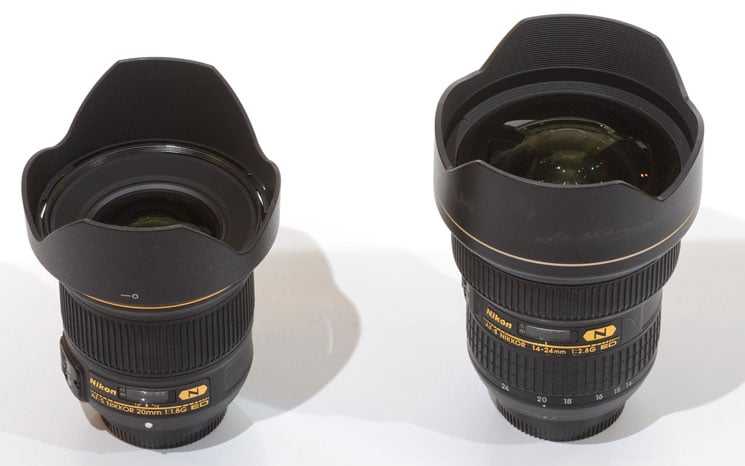 |
|
|
Comparing a fixed-focal to a zoom certainly is more like an apples-to-oranges comparison, But if you’re looking into high performance ultra-wide-angle lenses that auto-focus and fill a full-frame sensor it doesn’t seem too far-fetched to pitch both lenses against each other.
Rendering of out-of-focus point-light sources
The following test is for the rendering of point-light sources in an out-of-focus background. The circle of confusion that is produced by this test is pretty indicative of Bokeh performance (in the background) and light fall-off. Ideally the out-of-focus image of the point-light is an evenly lit and perfectly circular disc, with no “onion-rings”, and without coloration. Large aperture lenses normally produce an effect known as “cat’s eye” the further away from the optical axis the point-light is projected. This is due to optical vignetting in the lens barrel when light enters the lens from an angle. For an explanation of this effect have a look over at toothwalker.org. The following set of 50% crops from a night-shot show the results from the 20/1.8G in the first two rows compared to the Nikon 14-24/2.8G in the third row.
| Unsharp Unremarkables at Night: shot with Nikon AF-S 20/1.8G on a D800 | ||||
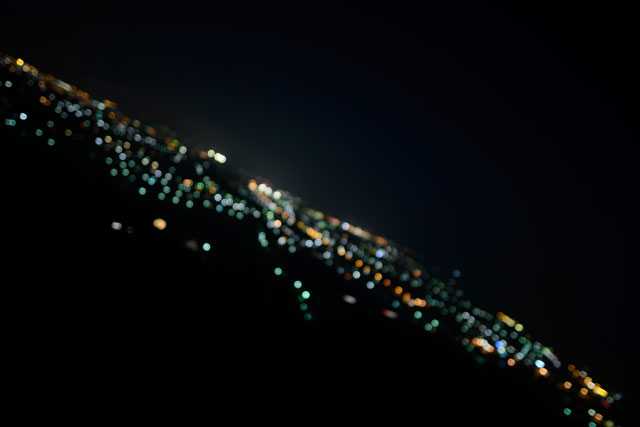 |
||||
| 20mm, f1.8, 100 ISO; Below: 50% crops from the main image at f1.8 | ||||
| f1.8, 100 ISO, center | f1.8, 100 ISO, DX-corner | f1.8, 100 ISO, FX-corner |
| f2.8, 100 ISO, center | f2.8, 100 ISO, DX-corner | f2.8, 100 ISO, FX-corner |
| Unsharp Unremarkables at Night: shot with Nikon AF-S 14-24mm f/2.8G at 20mm on a D800 | ||||
| f2.8, 100 ISO, center | f2.8, 100 ISO, DX-corner | f2.8, 100 ISO, FX-corner |
Well, wide-angle lenses never produce circles of confusion that are as big as from longer lenses. So at 20mm you cannot expect the same smooth background blur that a 50mm or 85mm lens provides. And that holds true even if your main subject in the foreground is reproduced at equal magnification – as is the case in my shots: all lenses that I test this way are focused so that a subject of 1m size would exactly fill the frame. That’s a magnification of around 1:30.
Still the 20/1.8G produces some substantially sized circles of confusion thanks to its large aperture. Unfortunately the blobs show outlining (some of that colored green) and onion-rings resulting probably from the aspherical lens-elements. Flattening of the circles or cat’s-eye effect is minimal towards the corners. So one could expect a Bokeh that is not too bad for such a wide-angle lens. Comparison to the results from the 14-24/2.8G at 20mm f2.8 clearly shows that 20/1.8G has the upper hand here: The zoom lens delivers very pronounced outlining (although with little coloration) that results in nervous Bokeh and also produces the smaller blobs even at an identical aperture of f2.8. Compare both lenses at their respective maximum apertures the 20/1.8G leaves the 14-24/2.8G in the dust with a circle of confusion that is twice the size. The other ultra wide-angle zooms even fare worse compared to the 14-24/2.8G as their maximum aperture is f3.5 or f4.0. So if you want the best background blur at such a short focal length, the 20/1.8G is hard to beat.
Обзор Nikon AF-S Nikkor 20mm f/1.8G ED – Качество изображения
Для пейзажных изображений объектив 20 мм f/1.8 оправдывает свои ожидания. Криволинейных искажений очень мало, о чем свидетельствует выбор автоматической коррекции профиля в Adobe Camera Raw или Lightroom. Нажатие кнопки вносит небольшую корректировку в изображение, но совсем не критично. Те, кто хочет снимать архитектуру или интерьеры, также должны найти реальное преимущество в минимальных искажениях.
Чрезвычайно широкий обзор можно снимать с помощью объектива 20 мм.
Виньетирование присутствует, как и следовало ожидать от объектива с таким фокусным расстоянием, и может быть заметно даже на f/8
Некоторых людей смущает виньетирование, но я к ним не отношусь — оно помогает привлечь внимание к центру кадра, и его легко убрать при редактировании
С точки зрения резкости углы действительно страдают при съемке с открытой диафрагмы. Однако на f/5.6 они намного резче, а на f/8 только самые углы имеют заметное падение разрешения от центра кадра.
При съемке прямо на солнце была заметна некоторая хроматическая аберрация в зелено-пурпурном цвете. Тем не менее, это был очень экстремальный тест, и я ожидал, что почти все объективы провалятся. Даже с небольшой аберрацией 20-миллиметровый прекрасно справился с испытанием, и опять же, преимущества современных технологий означают, что необработанный файл исправлялся одним нажатием кнопки, не оставляя от него никаких следов.
При использовании 20-мм объектива на цифровой зеркальной фотокамере с датчиком размера APS-C он становится эквивалентным 30-мм объективу с диафрагмой f/1,8 и использует самую резкую часть круга изображения. При таком использовании он даст вам резкость практически от края до края, которая ничуть не хуже, чем в самом центре кадра. Опять же, это то, что очень понравится пейзажным фотографам.
Однако больше всего мне понравилась диафрагма f/1.8. Фокусировка на объектах, которые находятся очень близко к объективу — даже настолько близко, насколько позволяет минимальное расстояние фокусировки 20 см, — означала, что я мог быть очень творческим при кадрировании изображений. Он предлагает что-то свое для всех типов фотографии, но, возможно, именно те, кто снимает видео, получат наибольшую творческую выгоду от этого объектива.
Изображение с диафрагмой f/1.8 (слева) снято почти на минимальном расстоянии фокусировки.
Как выбрать объектив на фотоаппарат Nikon
Изображения с высоким разрешением
Благодаря новому объективу NIKKOR 20 мм f/1,8, разработанному специально для съемки с высоким разрешением, вы сможете создавать потрясающие фотографии и видео в формате HD. Оптическая система современной конструкции содержит 13 элементов в 11 группах, в частности два элемента из стекла сверхнизкого рассеивания (ED) и две асферические линзы. Стекло ED от компании Nikon гарантирует резкость и контраст даже при больших значениях диафрагмы, а асферические линзы практически исключают вероятность искажения при широчайшем диапазоне фокусных расстояний. Нанокристаллическое покрытие Nano Crystal Coat сводит к минимуму двоение изображения и блики.
Rendering of point-light sources at night-shots
Night-shots pose a different challenge for lenses as the contrast is even higher than under bright sun and point-light sources can reveal some weaknesses such as coma, haloing and color-aberrations that do not show up as prominently in other test-shots. The following set of 100% crops from a night-shot show the results from the 20/1.8G at f1.8 and f2.8 in the first two rows compared to the 14-24/2.8G at 20mm and f2.8 in the third row shot only a few minutes apart:
| Unremarkables at Night: shot with Nikon AF-S 20/1.8G on a D800 | ||||
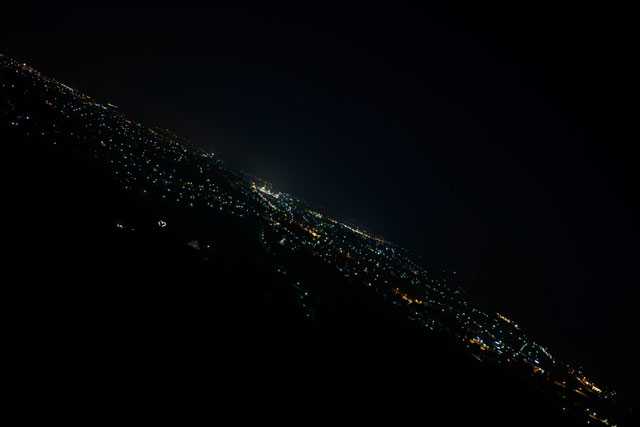 |
||||
| 20mm, f1.8, 100 ISO; Below: 100% crops from the main image at different apertures | ||||
| f1.8, 100 ISO, center | f1.8, 100 ISO, DX-corner | f1.8, 100 ISO, FX-corner |
| f2.8, 100 ISO, center | f2.8, 100 ISO, DX-corner | f2.8, 100 ISO, FX-corner |
| Unremarkables at Night: shot with Nikon AF-S 14-24mm f/2.8G at 20mm on a D800 | ||||
| f2.8, 100 ISO, center | f2.8, 100 ISO, DX-corner | f2.8, 100 ISO, FX-corner |
The strong light-sources reveal some coloration, haloing, and coma at f1.8. And like in the daylight shot the center cleans up nicely by stopping down to f2.8 while the DX- and FX-corner don’t change much. Compared to the 14-24/2.8G the 20/1.8G is clearer in the center by f2.8 and shows a lower amount of coma in the FX-corner. Comparing the DX-corner reveals that both lenses show different ways of blurring point-light sources with the 20/1.8G looking less like typical coma. Stopping down to f5.6 produces artifact-free point-lights (on both lenses) which is in-line with the observations from the daylight shots.
All-in-all the new Nikon AF-S 20mm f1.8G can produce pretty sharp results if you know its limits: At closer distances the lens is sharp in the center already at f1.8 and the roll-off towards the corners is well behaved if you don’t shoot flat objects. For landscape and architecture shots I’d advise against using this lens wide open. Even f2.8 leaves you wanting as soon as you need decent sharpness outside the center. If the situation allows it stop down to at least f4 and use f5.6 or f8 for best results across the full frame.
Focus and build quality
Focus accuracy and repeatability is critical to consistently produce sharp shots, especially with large aperture primes. Consistency of auto-focus (the accuracy of focus on the same subject after repeated focus-acquisition) of this lens is very good (98.1% as measured in FoCal) with only very slight variations and no real outlier over a series of 40 shots. The lens focuses in around 0.6 sec from infinity to 20 cm, which is pretty fast. The 28/1.8G does this in 0.7 sec.
The focus ring has some slack/play between its movement and the focus-action which is a nuisance for manual focusing. And the throw of around 80 degrees is pretty short for accurate focus wide open. The focus ring has a broad 2.4 cm wide profiled rubber surface that is easy to grip and moves easily albeit with a clear geared feeling. AF-operation is barely audible from the outside. If you record video with the built-in microphone focus-movement starts and stops with almost no “clack” and the AF-drive itself is also not too annoying. Focus breathing is visible: things in the background become clearly larger the closer you focus. That may annoy videographers.
The lens has a weather sealed metal lens-mount and seven rounded aperture blades. The outer barrel is plastic and the lens-hood sits tight.
Now it’s time to check out some results in my Nikon 20mm f1.8 quality and Nikon 20mm f1.8 sample images pages, or if you’d like to skip to chase, head straight for my verdict!
Перспектива с эффектом полного присутствия
Новый объектив NIKKOR 20 мм f/1,8 демонстрирует отменные результаты в самых различных условиях. Благодаря компактности и универсальности он прекрасно подходит для съемки интерьеров, репортажей на улице, панорамных пейзажей и даже подводного мира. Это отличный выбор для создания видеороликов с эффектом полного присутствия. Фотографы, которые хотят добиться полного погружения зрителя в свой творческий мир или часто снимают в ограниченных пространствах, по достоинству оценят все преимущества 20-миллиметрового фокусного расстояния и сверхширокий угол зрения, которые обеспечивают поразительные результаты.
Максимальная диафрагма f/1,8 и возможность концентрации большого потока световых лучей позволяют четко выделить объект на снимаемом фоне и обеспечивают красивую равномерную размытость заднего плана. Это дает возможность получить более яркое изображение в видоискателе, снимать с короткой выдержкой и делать четкие снимки в условиях недостаточной освещенности. Бесшумный ультразвуковой мотор (SWM) от компании Nikon обеспечивает плавную и бесшумную автофокусировку, а минимальное расстояние фокусировки 0,2 м позволяет с легкостью делать снимки в непосредственной близости от объекта, заполняя его изображением весь кадр.
Nikon AF-S Nikkor 20mm f/1.8G ED review – Features
The standout feature of Nikon’s 20mm f/1.8 lens is the combination of a wide focal length and large aperture. Designed for 35mm full-frame cameras, the 20mm focal length should be enough to capture even the widest vistas – although while such wideangle views can look very dramatic when you are there, they often fail to translate into a good photograph unless there is something interesting filling the space in the foreground. With this in mind, the f/1.8 aperture can be used to create a shallow depth of field ensuring that only the foreground subject is sharp, with the background creeping out of focus. It goes against landscape photography rules that dictate everything in the image must be sharp, but using a shallow depth of field can make for some very interesting images.
Those who shoot starlit landscapes will also enjoy the advantage of the f/1.8 aperture. Shooting such images, especially without introducing noise, relies on having a large aperture so that as much light from the stars can be captured as possible – the f/1.8 aperture should be able to capture both a dimly lit landscape and the stars. The old rule states that to keep the stars in the sky sharp, the exposure time should be no more than 600 divided by the focal length of the lens – a 30sec exposure should therefore be good enough when using a 20mm focal length.
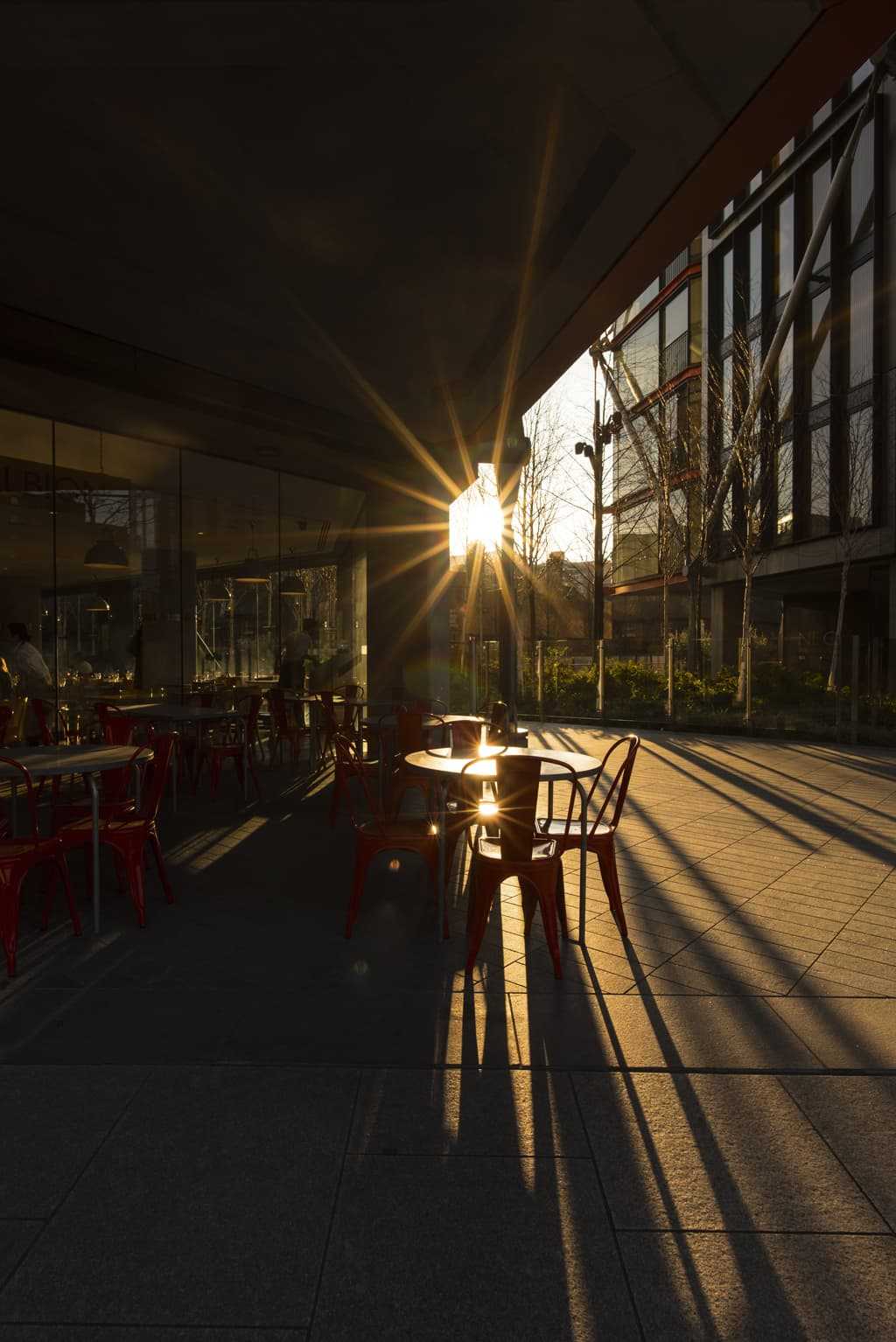
The seven-bladed aperture creates a lovely 14-point star-shaped lens flare when shooting into bright light
The 20mm f/1.8 lens uses Nikon’s Nano Crystal Coating to reduce flare and chromatic aberrations. There are two aspherical and two ED (extra-low dispersion) elements to ensure images are sharp and show minimal distortion.
Although the lens doesn’t have Nikon’s Vibration Reduction lens-based image stabilisation, this shouldn’t be an issue because it is possible to shoot handheld with this lens at around 1/30sec and still get sharp images.
Photographers will be pleased that this lens features a quiet Sonic Wave Motor (SWM), as well as being rear focusing. This means that the front lens doesn’t extend or rotate during focusing. This is a real benefit for users of filters such as polarisers or ND grads.
Facts from the catalog
As usual I’ll have a look at the technical data first. I’ve rated the features with a (or ), when it’s better than average or even state of the art, a if it’s standard or just average, and if there’s a disadvantage.
Most features are compared to Nikon’s AF-S 28/1.8G.
Size (diam. x length): 72 (body) / 82 (front) x 84 mm (2.8/3.2 x 3.3 in.). A little larger than the 28/1.8G at 73 x 81 mm.
Weight: 355 g (12.6 oz). 25g heavier than the 28/1.8G.
Optics: 13 lenses in 11 groups vs. 11 elements in 9 groups for the 28/1.8G. This is quite some glass even for a wide-angle lens. The lens contains two aspherical and two special glass element plus Nano-coating. The 28/1.8G has two aspherical elements plus Nano-coating too.
Closest focus distance/max. magnification: 20 cm (0.66 ft.) / 1:4.0 (measured). This is actually a quite nice magnification that this lens can achieve and is similar to the 28/1.8G which goes to 25 cm and 1/4.5.
Filter-thread: 77mm. That’s one of the professional standard sizes. The 28/1.8G has a 67mm filter-thread.
Image stabilization: No, same as any other fixed focal large aperture lens from Nikon or third parties below 200mm focal length.
AF: AF-S with SWM (silent wave motor), so it does work on Nikon D3x00/D5x00-bodies. Manual-focus override by simply turning the focus ring
Covers full frame/FX or smaller = very good
Price: around 800 EUR new (incl. 19% VAT). That’s quite a mark-up over the 28/1.8G which is at around 600 EUR. It makes the lens the most expensive f1.8G prime in Nikon’s line-up – but there’s not much competition around.
Comes with a flexible lens pouch (no padding, no strap), the lens-shade is included, reversible for transport, and the lens-caps are standard Nikon’s.
Distance information is relayed to the camera, so Nikon bodies and flashes can do all the advanced exposure-related stuff with this lens.
Aperture ring = no, just like all competitors with AF.
Sealing: yes! The standard Nikkor rubber grommet at the lens-mount – but no further weather-sealing.
The score in the “features-department” is 0/6/4. This lens ticks almost all important boxes, and the price may come down over time.
Nikon AF-S Nikkor 20mm f/1.8G ED review – Image quality
For landscape images, the 20mm f/1.8 lens delivers on its promise. There is very little curvilinear distortion, which is evidenced when selecting the automatic profile correction in Adobe Camera Raw or Lightroom. A press of the button makes a slight adjustment to the image, but it isn’t severe at all. Those wishing to shoot architecture or interiors should also find the minimum distortion a real benefit.
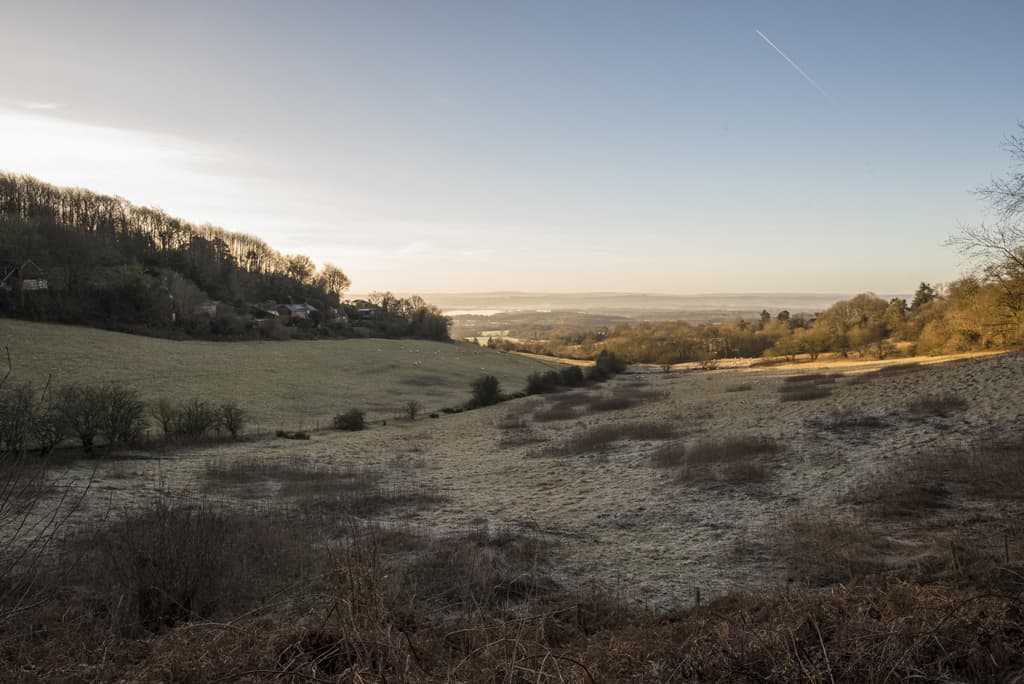
Extremely wide views can be captured with the 20mm lens
Vignetting is present, as you would expect from a lens of this focal length, and can be noticeable even at f/8. Vignetting bothers some people, but I’m not one of them – it helps draw the eye to the centre of the frame, and it can be easily removed when editing.
In terms of sharpness, the corners do suffer when shooting wide open. However, by f/5.6 they are much sharper, and at f/8 it is only the very corners that have a noticeable drop in resolution from the centre of the frame.
Shooting right into the sun, some green/magenta chromatic aberration was noticeable. However, this was a very extreme test that I would have expected almost all lenses to fail. Even with the slight aberration, the 20mm coped admirably with the ordeal, and again, the benefit of modern technology meant the raw file was corrected with the press of a button, leaving no trace of it at all.
When using the 20mm lens on a DSLR with an APS-C-sized sensor it becomes the equivalent of a 30mm f/1.8, and it uses the very sharpest part of the imaging circle. Used in this way it will give you virtually edge-to-edge sharpness that is every bit as good as the very centre of the frame. Again, this is something that will appeal greatly to landscape photographers.
However, the aspect I most enjoyed was the f/1.8 aperture. Focusing on subjects that are very close to the lens – even as close as the 20cm minimum focus distance will allow – meant that I could be very creative when framing images. It offers something different for all types of photography, but it is perhaps those shooting video who will benefit the most, creatively, from this lens.
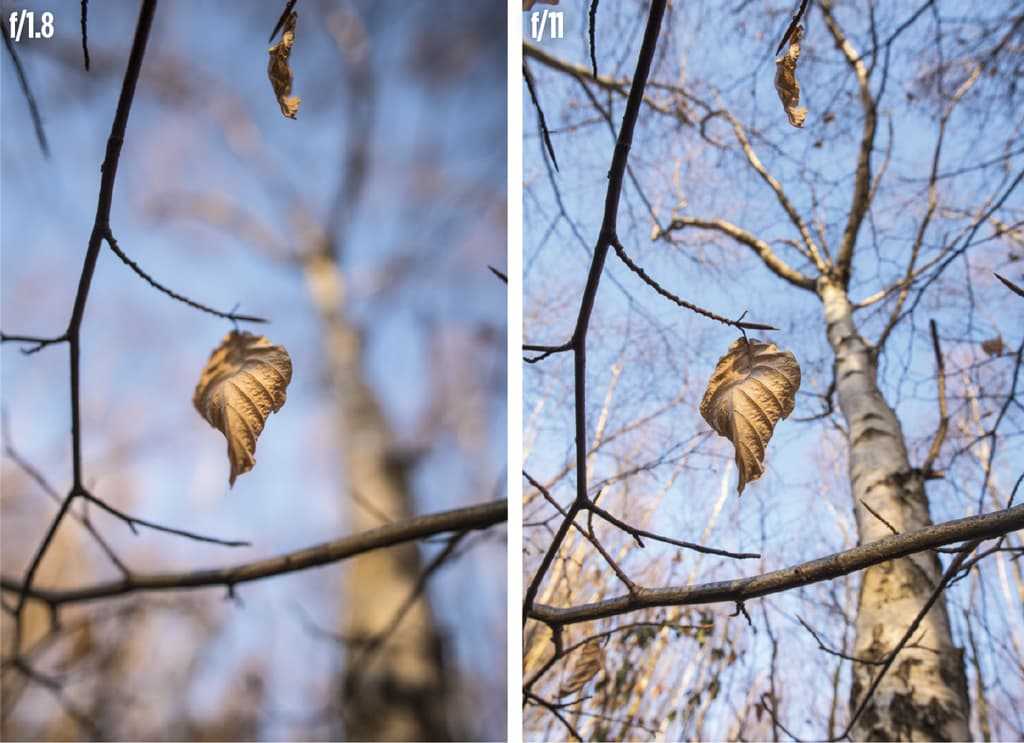
The f/1.8 aperture image (left) was shot almost at the minimum focus distance
Обзор Nikon AF-S Nikkor 20mm f/1.8G ED – сборка и обращение
Пользователи Nikon сразу же почувствуют себя как дома с этим объективом 20 мм f/1,8, поскольку он предлагает все знакомые объективы текущей серии G-серии. Имеется ребристое широкое кольцо фокусировки с небольшим окошком, показывающим текущую дистанцию фокусировки. Как обычно, это немного мало и не слишком подробно, но в наш цифровой век это не большая проблема, поскольку вы можете предварительно просмотреть фокусировку и глубину резкости в режиме реального времени. Небольшой переключатель сбоку на корпусе быстро переключается между ручной и автоматической фокусировкой, и, как и следовало ожидать, кольцо диафрагмы отсутствует, так как диафрагма изменяется электронным способом через камеру. Объектив имеет 77-миллиметровую резьбу для фильтра и поставляется со вставной блендой HB-72, но о внешнем виде объектива сказать больше нечего.
Одним заметным качеством является размер объектива, а также его вес. Все эти 13 новых элементов больше, чем в предыдущей версии объектива с диафрагмой f/2.8, что позволяет использовать достаточное количество света, чтобы сделать возможной диафрагму f/1.8. В результате объектив 20 мм f/1,8 имеет размеры 82,5 x 80,5 мм по сравнению с 69 x 54 мм объектива AF-D 20 мм f/2,8. Эта новая конструкция также увеличивает вес с 260 г до 355 г.
Тем не менее, текущая тенденция для многих производителей объективов заключается в том, что качество важнее удобства — Sigma 50mm f/1.4 DG HSM | Объектив является ярким примером этого. Существуют и другие объективы 50 мм f/1.4, которые меньше, легче и намного дешевле, но ни один из них не может сравниться с качеством изображения, предлагаемым оптикой Sigma Art.
Для этого теста я соединил объектив AF-S Nikkor 20mm f/1.8G ED с Nikon D750 и обнаружил, что они являются хорошими компаньонами. Объектив выглядит обнадеживающе прочным, а ручная фокусировка относительно проста. Использование автофокуса было особенно быстрым — даже при переключении с минимума на бесконечность он практически мгновенно фокусировался — а диафрагма f/1,8 обеспечивает достаточное количество света для автофокусировки даже в условиях низкой освещенности.
Лучшие телеобъективы
Reasons to Buy Nikon AF-S Nikkor 20mm f1.8G ED Lens
Here we’ve included a summary of the advantages and disadvantages of the Nikon AF-S Nikkor 20mm f1.8G ED lens in a list form to help you determine whether it offers the features you need.
PROs
| Autofocus |
| Distance Scale |
| Hood supplied |
| Full-time Manual Focusing |
| Internal Focusing |
| Fast Aperture |
| Covers Full-Frame Sensor |
| Minimum focus distance of 0.2m / 7.9 inch |
Report a correction
Buy Nikon 20mm f1.8G ED from or B&H PHOTO
CONs
| No Weather Sealing |
Lens Mount
Nikon 20mm f1.8G ED is compatible with cameras that have a Nikon F (DX) lens mount. Some of the latest released cameras that are compatible with the Nikon F (DX) lenses are Nikon D6, Nikon D780 and Nikon D3500.
Size, Weight and Filter Thread
Size and weight is a very important decision factor when searching for your next lens. Nikon 20mm f1.8G ED has a maximum diameter of 83mm and total length of 81mm. It weighs 355g / 12.5 oz.
Nikon 20mm f1.8G ED has a filter thread of 77mm. Below are links to the filters that we recommend you to consider for your Nikon 20mm f1.8G ED:
Optical Image Stabilization
Nikon 20mm f1.8G ED doesn’t have an optical image stabilization system so the only option to stabilize the image taken with this lens is to mount on a camera body with IBIS (sensor based In-body image stabilization).
Zoom Method
Nikon 20mm f1.8G ED features Rotary (internal) zoom method where the length of the lens doesn’t change while you are zooming in or out. Even though this design has a size disadvantage in general compared to extending designs, it has the benefits of better sealing against dust and moisture, no zoom creep and no weight balance shift while zooming.
Maximum Magnification Ratio
Nikon 20mm f1.8G ED has a Max Magnification Ratio of 0.23x and has a minimum focusing distance of 0.2m.
Below are the 3 Ultra-Wideangle Prime type Nikon F mount lens alternatives with highest max magnification ratios:
- Sigma 15mm F2.8 EX DG Fisheye: 0.26x — (Compare)
- Nikon PC 19mm F4E ED: 0.18x — (Compare)
- Sigma 20mm F1.4 DG HSM A: 0.14x — (Compare)
Optical Formula
Nikon 20mm f1.8G ED’s optical formula consists of 13 elements in 11 groups . Following special elements are used in this design:
- 2 ED
- 2 aspherical
Lens Hood
Nikon 20mm f1.8G ED comes with a removable lens hood which is handy to reduce lens flare and glare in your photos. The model number of the hood is HB-72.
Popular Comparisons of Nikon 20mm f1.8G ED
Top Alternatives of Nikon 20mm f1.8G ED Lens
| Model | Coverage | Weight | Focusing | Street Price | |
|---|---|---|---|---|---|
|
Nikon AF-S Nikkor 24mm f1.4G ED Compare |
35mm FF | 620 g / 1.36 lb | AF | ||
|
Nikon AF Nikkor 20mm f2.8D Compare |
35mm FF | 270 g / 0.59 lb | AF | ||
|
Sigma 20mm F1.8 EX DG Aspherical RF Compare |
35mm FF | 520 g / 1.14 lb | AF | ||
|
Sigma 20mm F1.4 DG HSM A Compare |
35mm FF | 950 g / 2.09 lb | AF | ||
|
Voigtlander 20mm F3.5 Color Skopar SL II Compare |
35mm FF | 205 g / 0.45 lb | MF | ||
|
Nikon AF-S Nikkor 24mm F1.8G ED Compare |
35mm FF | 355 g / 0.78 lb | AF | ||
|
Zeiss Milvus 18mm F2.8 Compare |
35mm FF | 721 g / 1.59 lb | MF | ||
|
Samyang 20mm F1.8 ED AS UMC Compare |
35mm FF | 497 g / 1.09 lb | MF |




























